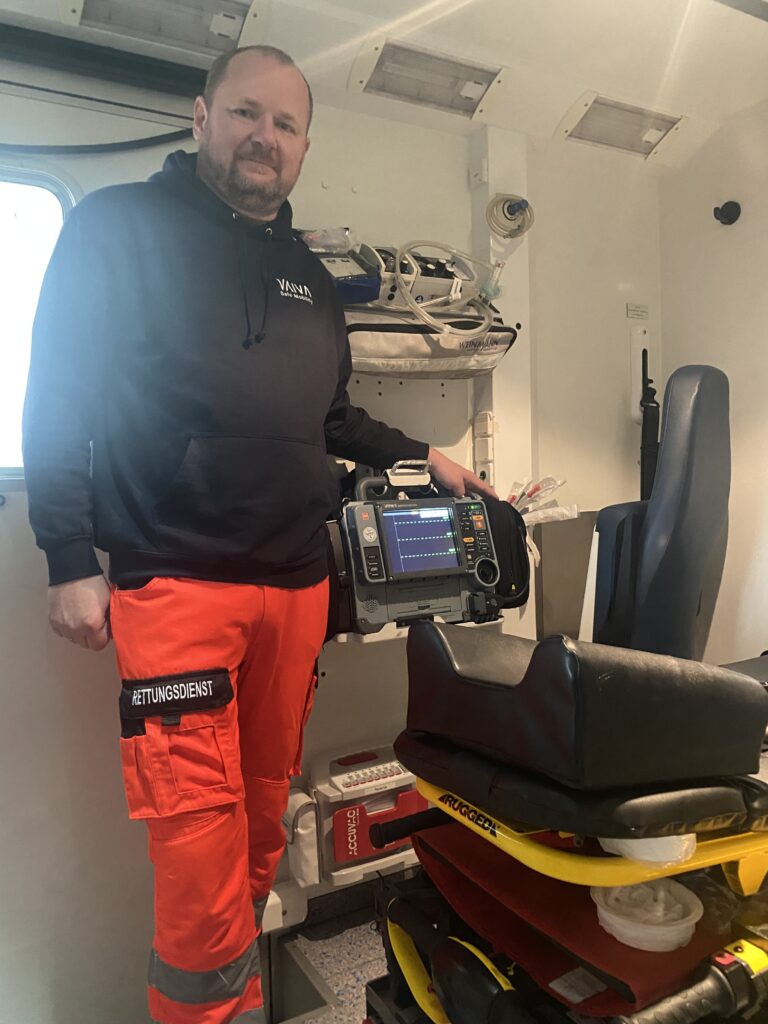A matter of the heart: AED for Gaimersheim site

The VAIVA management team has decided unanimously to purchase a publicly available Automatic External Defibrillator (AED). In an interview, our IT Manager and volunteer ambulance employee Sebastian explains what an AED actually is, why the ISO 9001 audit inspired to get an AED and why every minute counts in cardiac arrest.
Sebastian, VAIVA is all about safety in automated driving. What does safety mean to you?
With safety I got “in touch” already early. Flight safety has always been my hobby: What keeps the planes in the sky and how does it happen that they do not collide? That’s probably why I studied flight and vehicle informatics. Of course, I am also interested in safety in vehicle technology, but also in computer science: After all, I am also responsible for information security at VAIVA. So somehow I have the feeling that safety has been with me all my life (laughs).
During the corona pandemic, I decided to join the fire department and also the rescue services.
Speaking of rescue services: The VAIVA management team recently decided that we will get a publicly accessible Automatic External Defibillator (AED) for the Gaimersheim site. Can you explain why?
As luck would have it, we recently had the ISO 9001 audit with the auditor, who simply threw the question into the room as part of the occupational health and safety audit – together with Bastian – why VAIVA does not have an AED. The auditor said that the AED had to be used in his company – with a colleague with cardiac arrest. In the debriefing of the audit, in which I was also present, the topic was then raised again by the auditor – I became aware of it since I already have experience with the AED. From that point on, I supported with my knowledge, as I work in the rescue service and the whole topic of “resuscitation” is very often on my mind – it is a matter of the heart to me.
I contacted Bastian and we checked what an AED would cost. Then everything went very, very quickly. The proposal was presented at the MTM [MTM = Management Team Meeting] and less than five days later the “go” came from all directions, including from the finance department.
You just said you already have experience with the AED?
The so-called early defibrillation is of course part of the rescue service training that I have gone through. I then decided to continue my training, so by now I have the second highest medical training in voluntary work and am now on my way to becoming a paramedic – the highest medical training that can be achieved in voluntary work. The use of the AED is part of the training – because it is very important that the AED is used in the event of cardiac arrest.
I hope it never happens, but in case I found a person in the company who is unconscious and no longer breathing: Wouldn’t it be enough if I alerted the emergency services?
That is indeed not enough. From the moment someone stops breathing, the heart quickly stops beating. There is no longer any circulation and the oxygen that is in the body is no longer distributed. Our most “critical” instrument in the body is the one we use most often: the brain.
The brain is damaged very quickly when it runs out of oxygen. Unfortunately, the rescue service needs an average of 12 minutes from the alarm to arrival at the scene – of course, it also depends on how far away you are from the rescue service. After the 12 minutes, the people get out of the ambulance – the situation is not yet clarified at that time. If the rescue equipment is tied up in a serious accident, then it can also take longer for the rescue service to arrive.
The problem is that after four minutes, our brain begins to be irreversibly damaged. It is said that after about seven minutes without oxygen, the person – if he can be revived – will retain permanent damage. After 10 minutes without oxygen, there is usually no chance that the person will survive. So if I call the ambulance service and it takes 10 minutes, then unfortunately it will no longer help the patient.
It is great that we will have an AED at the Gaimersheim location in the future. Is there a way to familiarize yourself with the AED beforehand so that you feel safer and use the AED in an emergency?
The topic is literally close to my heart and therefore I already had the idea that I would train or post-school interested employees for cardiopulmonary resuscitation.
Everyone who has a driver’s license has undergone a first aid training – depending on how old you are or how long you have the driver’s license, this training is already a few years or decades ago. The basics have then been forgotten. And some things have changed that you do differently now.
I would like to take this opportunity for VAIVA employees to deal with pure cardiopulmonary resuscitation – “pressing” – and learn how to use an AED.
I believe that if you have repeated that, tried it again, then people are actually much more willing to help if the worst comes to the worst. Many are afraid of harm – you can’t do that. The worst thing you can do is do nothing.